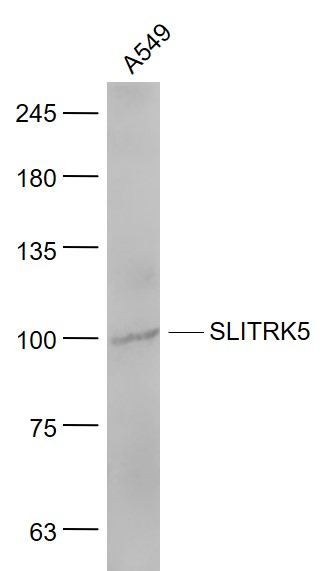
Rabbit Anti-SLITRK5 antibody
bA364G4.2; KIAA0918; Leucine rich repeat containing 11; Leucine rich repeat containing protein 11; LRRC 11; LRRC11; SLIT and NTRK like family member 5; SLIT and NTRK like protein 5; Slit and trk like gene 5; SLITRK 5; SLIK5_HUMAN.
View History [Clear]
Details
Product Name SLITRK5 Chinese Name 神经突触相关蛋白SLITRK5抗体 Alias bA364G4.2; KIAA0918; Leucine rich repeat containing 11; Leucine rich repeat containing protein 11; LRRC 11; LRRC11; SLIT and NTRK like family member 5; SLIT and NTRK like protein 5; Slit and trk like gene 5; SLITRK 5; SLIK5_HUMAN. Research Area Cell biology Neurobiology The cell membrane蛋白 Immunogen Species Rabbit Clonality Polyclonal React Species Human, (predicted: Mouse, Rat, Dog, Pig, Cow, Horse, Sheep, ) Applications WB=1:500-2000 ELISA=1:5000-10000 IHC-P=1:100-500 IHC-F=1:100-500 ICC=1:100-500 IF=1:100-500 (Paraffin sections need antigen repair)
not yet tested in other applications.
optimal dilutions/concentrations should be determined by the end user.Theoretical molecular weight 103kDa Cellular localization The cell membrane Form Liquid Concentration 1mg/ml immunogen KLH conjugated synthetic peptide derived from human SLITRK5: 301-400/958 <Extracellular> Lsotype IgG Purification affinity purified by Protein A Buffer Solution 0.01M TBS(pH7.4) with 1% BSA, 0.03% Proclin300 and 50% Glycerol. Storage Shipped at 4℃. Store at -20 °C for one year. Avoid repeated freeze/thaw cycles. Attention This product as supplied is intended for research use only, not for use in human, therapeutic or diagnostic applications. PubMed PubMed Product Detail The leucine-rich (LRR) repeat is a 20-30 amino acid motif that forms a hydrophobic å/∫ horseshoe fold, allowing it to accommodate several leucine residues within a tightly packed core. All LRR repeats contain a variable segment and a highly conserved segment, the latter of which accounts for 11 or 12 residues of the entire LRR motif. SLITRK5 (SLIT and NTRK-like family, member 5), also known as LRRC11 (leucine-rich repeat-containing protein 11), is a 958 amino acid single-pass type I membrane protein that contains 16 LRR repeats and belongs to the SLITRK family. Expressed at high levels in the cerebral cortex, but also present in areas of the spinal cord and medulla, SLITRK5 functions to suppress neurite outgrowth, thereby playing a regulatory role in neuronal function. The gene encoding SLITRK5 maps to human chromosome 13, which houses over 400 genes, such as BRCA2 and RB1, and comprises nearly 4% of the human genome. Trisomy 13, also known as Patau syndrome, is deadly and the few who survive past one year suffer from permanent neurologic defects, difficulty eating and vulnerability to serious respiratory infections.
Function:
SLIT and NTRK-like family 5 (SLITRK5) is a member a protein family consisting of six homologous transmembrane proteins (SLITRK1-6) that share two conserved leucine-rich repeat domains in the extracellular domain and have significant homology to Slit, a secreted axonal growth-controlling protein. These proteins are also homologous to trk neurotrophin receptors in their intracellular domains. Expression of SLITRK proteins is highly restricted to neural and brain tumor tissues, but varies within the protein family. Like every other SLITRK protein except SLITRK1, overexpression of SLITRK5 inhibited neurite outgrowth in cultured neurons, suggesting that these proteins are involved in the control of neurite outgrowth.
Subcellular Location:
Membrane; Single-pass type I membrane protein.
Tissue Specificity:
Expressed predominantly in the cerebral cortex of the brain but also at low levels in the spinal cord and medulla.
Similarity:
Belongs to the SLITRK family.
Contains 12 LRR (leucine-rich) repeats.
Contains 2 LRRCT domains.
Contains 1 LRRNT domain.
SWISS:
O94991
Gene ID:
26050
Database links:Entrez Gene: 26050 Human
Entrez Gene: 75409 Mouse
Omim: 609680 Human
SwissProt: O94991 Human
SwissProt: Q810B7 Mouse
Unigene: 591208 Human
Product Picture
Partial purchase records(bought amounts latest0)
No one bought this product
User Comment(Total0User Comment Num)
- No comment



 +86 571 56623320
+86 571 56623320




